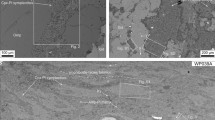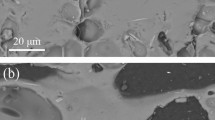Abstract
Recent stratigraphic studies at Vesuvius have revealed that, during the past 4,000 years, long lasting, moderate to low-intensity eruptions, associated with continuous or pulsating ash emission, have repeatedly occurred. The present work focuses on the AS1a eruption, the first of a series of ash-dominated explosive episodes which characterized the period between the two Subplinian eruptions of 472 AD and 1631 AD. The deposits of this eruption consist of an alternation of massive and thinly laminated ash layers and minor well sorted lapilli beds, reflecting the pulsatory injection into the atmosphere of variably concentrated ash-plumes alternating with Violent Strombolian stages. Despite its nearly constant chemical composition, the juvenile material shows variable external clast morphologies and groundmass textures, reflecting the fragmentation of a magma body with lateral and/or vertical gradients in both vesicularity and crystal content. Glass compositions and mineralogical assemblages indicate that the eruption was fed by rather homogeneous phonotephritic magma batches rising from a reservoir located at ~ 4 km (100 MPa) depth, with fluctuations between magma delivery and magma discharge. Using crystal size distribution (CSD) analyses of plagioclase and leucite microlites, we estimate that the transit time of the magma in the conduit was on the order of ~ 2 days, corresponding to an ascent rate of around 2 × 10−2 ms−1. Accordingly, assuming a typical conduit diameter for this type of eruption, the minimum duration of the AS1a event is between about 1.5 and 6 years. Magma fragmentation occurred in an inertially driven regime that, in a magma with low viscosity and surface tension, can act also under conditions of slow ascent.







Similar content being viewed by others
References
Andronico D, Cioni R (2002) Contrasting styles of Mount Vesuvius activity in the period between the Avellino and Pompeii Plinian eruptions, and some implications for assessment of future hazards. Bull Volcanol 64:372–391
Andronico D, Calderoni G, Cioni R, Sbrana A, Sulpizio R, Santacroce R (1995) Geological map of Somma-Vesuvius volcano. Period Mineral 64:77–78
Andronico D, Branca S, Calvari S, Burton M, Caltabiano T, Corsaro RA, Del Carlo P, Garfì G, Lodato L, Miraglia L, Murè F, Neri M, Pecora E, Pompilio M, Salerno G, Spampinato L (2005) A multi-disciplinary study of the 2002–03 Etna eruption: insights into a complex plumbing system. Bull Volcanol 67:314–330
Andronico D, Scollo S, Caruso S, Cristaldi A (2008) The 2002–03 Etna explosive activity: Tephra dispersal and features of the deposits. J Geophys Res. doi:10.1029/2007JB005126
Arellano SR, Hall M, Samaniego P, Le Pennec JL, Ruiz A, Molina I, Yepes H (2008) Degassing patterns of Tungurahua volcano (Ecuador) during the 1999–2006 eruptive period, inferred from remote spectroscopic measurements of SO2 emissions. J Volcanol Geotherm Res 176:151–162
Arrighi S, Principe C, Rosi M (2001) Violent strombolian and subplinian eruptions at Vesuvius during post-1631 activity. Bull Volcanol 63:126–150
Baldridge WS, Carmichael IS, Albee AL (1981) Crystallization paths of leucite-bearing lavas: examples from Italy. Contrib Mineral Petrol 76:321–335
Blong RJ (1984) Volcanic hazards. Academic, Australia, pp 1–424
Blower JD (2001) Factors controlling permeability–porosity relationships in magma. Bull Volcanol 63:497–504
Bonaccorso A (2006) Explosive activity at Mt. Etna summit craters and source modeling by using high-precision continuous tilt. J Volcanol Geotherm Res 158:221–234
Bonadonna C, Ernst GGJ, Sparks RSJ (1998) Thickness variations and volume estimates of tephra fall deposits: the importance of particle Reynolds number. J Volcanol Geotherm Res 81:173–187
Calvari S, Coltelli M, Neri M, Pompilio M, Scribano V (1994) The 1991–93 Etna eruption: chronology and lava flow field evolution. Acta Vulcanol 4:1–14
Carmichael ISE, Turner FJ, Verhoogen J (1974) Igneous petrology. McGraw-Hill, New York, pp 427–484
Cas RAF, Wright JV (1987) Volcanic successions: modern and ancient. A geological approach to processes, products and successions. Allen and Unwin, London, pp 1–518
Cashman KV (1992) Groundmass crystallization of Mount St Helens dacite 1980–1986: a tool for interpreting shallow magmatic processes. Contrib Mineral Petrol 109:431–449
Cashman KV, Marsh BD (1988) Crystal size distribution (CSD) in rocks and the kinetics and dynamics of crystallization II. Makaopuhi lava lake. Contrib Mineral Petrol 99:292–305 sections: estimation of crystal habit and true size. Am Mineral 79:113–119
Cioni R, Sbrana A, Vecci R (1992) Morphologic features of juvenile pyroclasts from magmatic and phreatomagmatic deposits of Vesuvius. J Volcanol Geotherm Res 51:61–78
Cioni R, Marianelli P, Santacroce R (1999) Temperature of Vesuvius magmas. Geology 27:443–446
Cioni R, Bertagnini A, Santacroce R, Andronico D (2008a) Explosive activity and eruption scenarios at Somma-Vesuvius (Italy): a review. J Volcanol Geotherm Res. doi:10.1016/j.jvolgeores.2008.04.024
Cioni R, D’Oriano C, Bertagnini A (2008b) Fingerprinting ash deposits by their physical and textural features. J Volcanol Geotherm Res 177:277–287
Coltelli M, Del Carlo P, Vezzoli L (1998) Discovery of a Plinian basaltic eruption of Roman age at Etna volcano, Italy. Geology 26:1095–1098
Davidson JP, Morgan DJ, Charlier BLA, Harlou R, Hora JM (2007) Microsampling and isotopic analysis of igneous rocks: implications for the study of magmatic systems. Annu Rev Earth Planet Sci 35:273–311
Deer WA, Howie RA, Zussman J (1965) Rock forming minerals. Longmans, London
Devine JD, Gardner JE, Brack HP, Lyne G, Rutherford MJ (1995) Comparison of microanalytical methods for estimating H2O contents of silicic volcanic glasses. Am Mineral 80:319–328
Fenn PM (1977) The nucleation and growth of alkali feldspars from hydrous melts. Can Mineral 15:135–161
Fierstein J, Nathenson M (1992) Another look at the calculation of fallout tephra volumes. Bull Volcanol 54:156–167
Gittings J (1979) The feldspathoidal alkaline rocks. In: Yoder HS Jr (ed) The evolution of the igneous rocks. Princeton University Press, New Jersey
Gudmundsson MT, Pedersen R, Vogfjörd K, Thorbjarnardóttir B, Jakobsdóttir S, Roberts MJ (2010) Eruptions of Eyjafjallajökull Volcano, Iceland. EOS Trans Am Geophys Union. doi:10.1029/2010EO210002
Heiken G, Wohletz KH (1985) Volcanic ash. University of California Press, Berkeley, p 245
Higgins MD (1994) Determination of crystal morphology and size from bulk measurements on thin sections: numerical modeling. Am Mineral 79:113–119
Higgins MD (2006a) Use of appropriate diagrams to determine if crystals size distributions (CSD) are dominantly semi-logarithmic, lognormal or fractal (scale invariant). J Volcanol Geotherm Res 154:8–16
Higgins MD (2006b) Quantitative textural measurements in igneous and metamorphic petrology. Cambridge University Press, 264 p
Horwell CJ, Sparks RSJ, Brewer TS, Llewellin EW, Williamson BJ (2003) Characterization of respirable volcanic ash from the Soufrière Hills volcano, Montserrat, with implications for human health hazards. Bull Volcanol 65:346–362
Houghton BF, Gonnermann HM (2008) Basaltic explosive volcanism: constraints from deposits and models. Chem Erde 68:117–140
Houghton BF, Nairn IA (1991) The 1976–1982 Strombolian and phreatomagmatic eruptions of White Island, New Zealand: eruptive and depositional mechanisms at a ‘wet’ volcano. Bull Volcanol 54:25–49
Houghton BF, Wilson CJN (1989) A vesicularity index for pyroclastic deposits. Bull Volcanol 51:451–462
Inman DL (1952) Measures for describing the size distribution of sediments. J Sediment Petrol 22:125–145
Jenkins SF, Magill CR, McAneney KJ (2007) Multi—stage volcanic event: a statistical investigation. J Volcanol Geotherm Res 161:275–288
Luth WC (1967) Studies in the system KAlSi2O8-Mg2SiO4-SiO2-H2O: I. Inferred phase relations and petrologic application. J Petrol 8:372–416
Maclennan J (2008) Concurrent mixing and cooling of melts under Iceland. J Petrol 49:1931–1953
Marsh BD (1998) On the interpretation of crystal size distributions in magmatic systems. J Petrol 39:553–600
Martin-Del Pozzo AL, González-Morán T, Espinasa-Pereña R, Butron MA, Reyes M (2007) Characterization of the recent ash emission at Popocatepetl Volcano, Mexico. J Volcanol Geotherm Res 170:61–75
Miyabuchi Y, Ikebe S, Watanabe K (2008) Geological constraints on the 2003–2005 ash emissions from the Nakadake crater lake, Aso Volcano, Japan. J Volcanol Geotherm Res 179:169–183
Morrissey M, Mastin LG (2000) Vulcanian eruptions. In: Sigurdsson H (ed) Encyclopedia of volcanoes. Academic, San Diego, pp 463–475
Namiki A, Manga M (2008) Transition between fragmentation and permeable outgassing of low viscosity magmas. J Volcanol Geotherm Res 169:48–60
Parfitt EA (2004) A discussion of the mechanisms of explosive basaltic eruptions. J Volcanol Geotherm Res 134:77–107
Pyle DM (1989) The thickness, volume and grain-size of tephra fall deposits. Bull Volcanol 51:1–15
Rojas-Ramos M, Catalan-Vazques M, Martin-Del Pozzo AL, Garcia-Ojeda E, Villalba-Caloca J, Perez-Neria J (2001) A seven months prospective study of the respiratory effects of exposure to ash from Popocatepetl volcano, Mexico. Environ Geochem Health 23:383–396
Rolandi G, Petrosino P, McGeehin JP (1998) The interplinian activity at Somma Vesuvius in the last 3500 years. J Volcanol Geotherm Res 82:19–52
Santacroce R (1987) Somma Vesuvius. In: CNR (eds) Quaderni della Ricerca Scientifica 114, 251 pp
Scaillet B, Pichavant M, Cioni R (2008) Upward migration of Vesuvius magma chamber over the past 20, 000 years. Nature 455:216–219
Scollo S, Del Carlo P, Coltelli M (2007) Tephra fallout of 2001 Etna flank eruption: analysis of the deposit and plume dispersion. J Volcanol Geotherm Res 160:147–164
Shea T, Larsen JF, Gurioli L, Hammer JE, Houghton BF, Cioni R (2009) Leucite crystals: surviving witnesses of magmatic processes preceding the 79 AD eruption at Vesuvius, Italy. Earth Planet Sci Lett 281:88–98
Sparks RSJ, Bursik MI, Carey SN, Gilbert JS, Glaze LS, Sigurdsson H, Woods AW (1997) Volcanic plumes. Wiley, Chichester, p 574
Spilliaert N, Allard P, Métrich N, Sobolev AV (2006) Melt inclusion record of the conditions of ascent, degassing, and extrusion of volatile-rich alkali basalt during the powerful 2002 flank eruption of Mount Etna (Italy). J Geophys Res. doi:10.1029/2005JB003934
Sweeney D, Kyle PR, Oppenheimer C (2008) Sulfur dioxide emissions and degassing behavior of Erebus volcano, Antarctica. J Volcanol Geotherm Res 177:725–733
Taddeucci J, Pompilio M, Scarlato PG (2004) Conduit processes during the July–August 2001 explosive activity of Mt. Etna (Italy): inferences from glass chemistry and crystal size distribution of ash particles. J Volcanol Geotherm Res 137:33–54
Vergniolle S, Boichu M, Caplan-Auerbach J (2004) Acoustic measurements of the 1999 basaltic eruption of Shishaldin Volcano, Alaska: 1. origin of Strombolian activity. J Volcanol Geotherm Res 137:109–134
Walker GPL, Croasdale R (1971) Characteristics of some basaltic pyroclastics. Bull Volcanol 35:303–317
Yoshida S, Koyaguchi T (1999) A new regime of volcanic eruption due to the relative motion between liquid and gas. J Volcanol Geotherm Res 89:303–315
Acknowledgements
This work was partially funded by the Italian “Dipartimento della Protezione Civile” in the frame of the 2004–2006 agreement with Istituto Nazionale di Geofisica e Vulcanologia—INGV, project V3_4/11 “V3_4 - Vesuvio”, to R Cioni. The work of C D’Oriano was founded by MIUR project: Advancing Interdisciplinary Research Platform on Volcanoes and Earthquakes (AIRPLANE). Helpful comments were provided by S Nakada, JDL White, A Volentik and an anonymous reviewer and they are gratefully acknowledged. We are grateful to P Pantani for graphical assistance and A Cavallo for technical assistance in EMP analysis.
Author information
Authors and Affiliations
Corresponding author
Additional information
Editorial responsibility: S. Nakada
Electronic supplementary material
Below is the link to the electronic supplementary material.
ESM 1
(DOC 51 kb)
Fig. I
Vesicle volume distributions of all ash fragments. L is the vesicles diameter in μm. For the characterization of the three groups of ash fragments see Table 2 in the text. (GIF 22 kb)
Fig. II
a) Composition of feldspar microlites represented on the feldspar ternary diagram. Core-rim pairs are indicated. b) Plot of pyroxene microlites composition. open circles: top of the eruption (L5); square: lapilli rich-layer (L4); filled circles: base of the eruption (L2). (GIF 18 kb)
Rights and permissions
About this article
Cite this article
D’Oriano, C., Cioni, R., Bertagnini, A. et al. Dynamics of ash-dominated eruptions at Vesuvius: the post-512 AD AS1a event. Bull Volcanol 73, 699–715 (2011). https://doi.org/10.1007/s00445-010-0432-1
Received:
Accepted:
Published:
Issue Date:
DOI: https://doi.org/10.1007/s00445-010-0432-1




